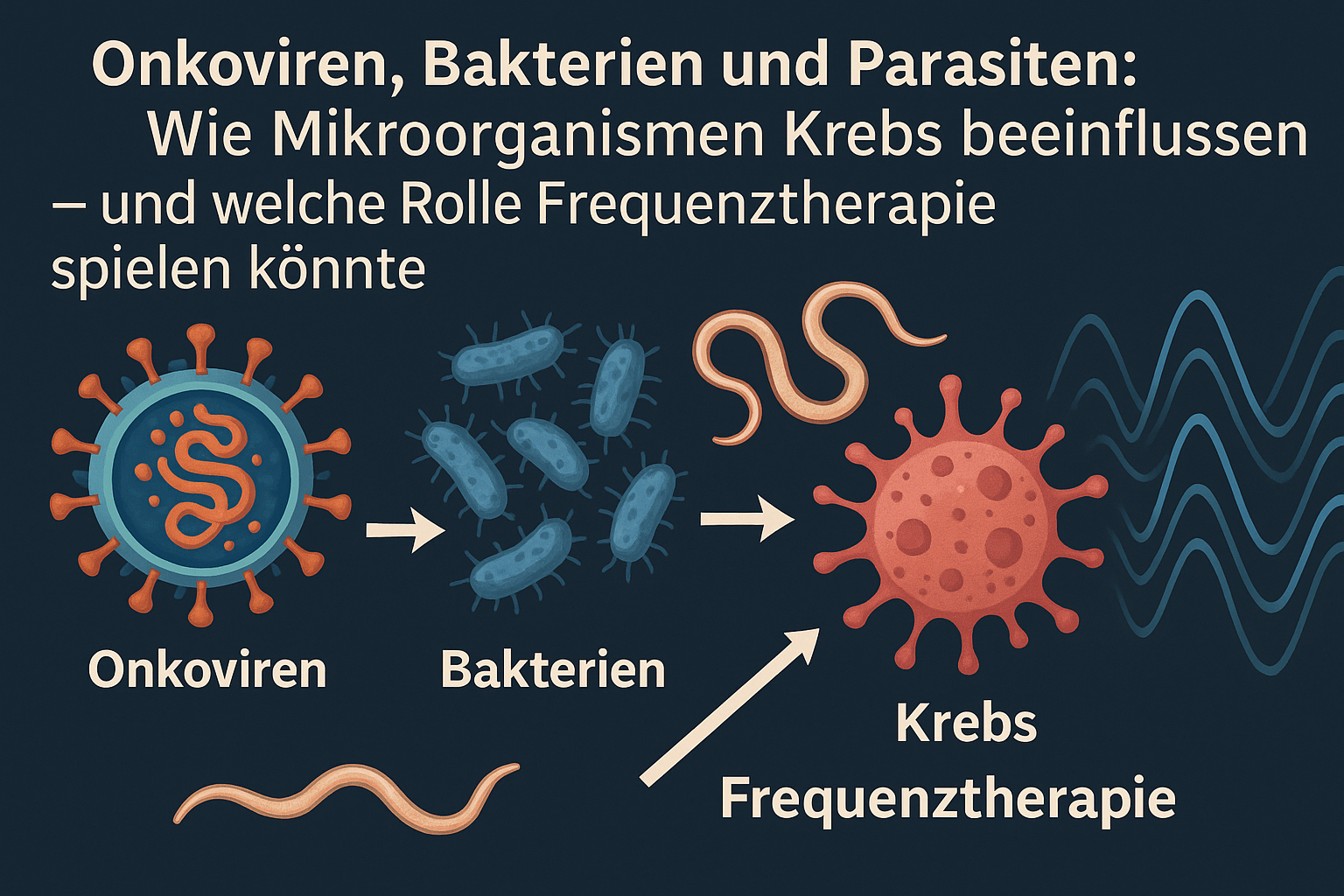
🧬 Oncoviruses, bacteria and parasites: How microorganisms influence cancer - and what role frequency therapy could play
Introduction: Invisible enemies in the body
Cancer is no longer just a genetic disease. More and more research shows: Infectious agents such as viruses, bacteria and parasites can play a decisive role in the development of cancer.
According to WHO estimates, up to 20 % of all cancers are attributable to infections.
At the same time, an older concept from biophysics is attracting new attention: frequency therapy. It is based on the assumption that every biological system - from cells to microorganisms - has its own oscillation frequencies. Targeted frequencies are used to influence or deactivate pathological structures.
Oncoviruses: when viruses cause cells to degenerate
What are oncoviruses?
Oncoviruses are viruses that alter the genetic material of host cells, thereby triggering uncontrolled cell growth. They introduce their DNA or RNA into the cell nucleus and influence genes that control cell division and DNA repair.
Known representatives:
-
HPV (human papillomavirus) → cervical and laryngeal cancer
-
EBV (Epstein-Barr virus) → lymphomas, nasopharyngeal carcinoma
-
HBV/HCV → Liver cancer
-
HHV-8 → Kaposi's sarcoma
How frequencies could work here
In vitro experiments show that electromagnetic fields (EMF) and targeted frequencies inhibit viral:
-
inhibit viral replication processes,
-
Destabilise viral capsid proteins,
-
and modulate the immune response.
These effects are based on resonance phenomena between electromagnetic waves and molecular structures of proteins or RNA.
Bacteria and cancer: the underestimated microbiome connection
How bacteria can promote tumours
Chronic bacterial infections lead to persistent inflammation, DNA damage and epigenetic changes. Examples:
-
Helicobacter pylori → stomach cancer
-
Fusobacterium nucleatum → colon cancer
-
Chlamydia trachomatis → ovarian cancer
Bacteria also change the pH value, promote oxygen deficiency and create a pro-oxidative microenvironment - ideal conditions for tumour cells.
Frequency therapy for bacterial infections
This is where frequency therapy comes in experimentally:
Certain frequencies in the kilohertz to megahertz range can destabilise bacterial membranes or weaken biofilms - without promoting antibiotic resistance.
This has been observed in laboratory studies on E. coli, Pseudomonas and Staphylococcus aureus.
Parasites and worms: the repressed risk factor
How worm infections favour cancer
Parasitic infections are a significant, often overlooked cancer factor in tropical countries.
Examples:
-
Schistosoma haematobium → bladder cancer
-
Clonorchis sinensis (Chinese liver fluke) → liver carcinoma
-
Opisthorchis viverrini → Bile duct carcinoma
These parasites cause chronic tissue damage and promote DNA mutation through inflammatory stimuli.
Frequency resonance in parasitic structures
Parasites have complex cell membranes with specific resonance properties.
Hypothesis: If an electromagnetic field oscillates at a frequency that corresponds to the "natural frequency" of the parasite, resonance destruction can occur - similar to the breaking of a glass by sound.
Frequency therapy: scientific principles
Cell resonance and electromagnetic oscillations
Every cell has a characteristic natural frequency - depending on its mass, conductivity and membrane structure.
Pathological cells, viruses or microbes differ measurably from healthy cells.
Targeted frequency application (microcurrent, magnetic field, ultrasound) can theoretically be used to:
-
Change metabolic activity,
-
Depolarise cell membranes,
-
or weaken pathogenic microorganisms.
Frequency-specific microcurrent therapy (FSM)
FSM uses microcurrents with specific frequencies that are customised to tissue and cell types. Studies show effects on:
-
Inflammatory markers (TNF-α, IL-1β),
-
ATP production,
-
Pain relief and
-
Tissue regeneration.
Historical approaches
As early as the 1930s, Royal Raymond Rife researched resonance-based frequencies to inactivate microorganisms.
Modern approaches take up this idea again with more precise technology (e.g. microcurrents, pulsed fields, bioresonance devices) - albeit with much stricter scientific standards.
Current state of research: Frequency effects on microorganisms
Viruses and bacteria under electromagnetic fields
Several peer-reviewed studies have observed:
-
Inhibition of virus replication by ELF fields (extremely low frequency)
-
Changes in bacterial enzyme activity
-
Disturbance of cell division in microorganisms
Resonance destruction - hypothesis
The theory: Certain frequencies generate micromechanical vibrations in the cell walls of microorganisms. These can disrupt membrane integrity or open ion channels - without thermal heating.
Criticism and limitations
Frequency therapy is not yet fully recognised scientifically.
Many studies show positive laboratory results, but:
-
large-scale clinical studies are lacking,
-
Frequency parameters are inconsistent,
-
Placebo effects must be ruled out.
Future prospects: Integration of frequency medicine and oncology
The future could lie in hybrid therapy concepts:
Frequency therapy not as a substitute, but as a complementary method in oncology.
Possible applications:
-
targeted immune activation through frequency-based stimuli,
-
Modulation of the microbiome,
-
Disruption of pathogenic biofilms,
-
Reduction of oxidative stress in tumour environments.
Combined with immunotherapy, nutrition and microbiome modulation, frequency medicine could become a new component of personalised cancer treatment.
FAQ - Frequently asked questions
1.What are oncoviruses?
Viruses that can cause cancer through genetic changes (e.g. HPV, EBV, HBV).
2.Can parasites really cause cancer?
Yes - certain types of worms promote chronic inflammation, which encourages tumour formation.
3.How does frequency therapy work?
It uses electromagnetic or electrical oscillations to trigger resonances in tissue or microorganisms.
4.Is frequency therapy scientifically proven?
There are numerous laboratory studies, but only limited clinical evidence. Research is ongoing.
5.Can frequency therapy cure cancer?
No - it is currently only considered as a supportive or complementary measure.
Conclusion: Between cell biology and vibration therapy
Viruses, bacteria and parasites play a greater role in cancer than has long been assumed.
Frequency therapy offers a fascinating approach to modulating biological processes on an energetic level - with growing research interest, but also justified scepticism.
The future probably lies in the combination of classical oncology and biophysics - in a new understanding of disease, energy and cell communication.
